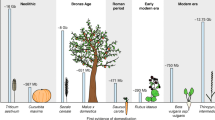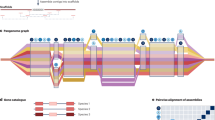
Overview
- This 10-volume-work is the first comprehensive depiction of wild crops as a gold mine for breeding
- With chapters authored by internationally reputed leading scientists
- Richly illustrated work
- Includes supplementary material: sn.pub/extras
Access this book
Tax calculation will be finalised at checkout
Other ways to access
About this book
Wild crop relatives are now playing a significant part in the elucidation and improvement of the genomes of their cultivated counterparts. This work includes comprehensive examinations of the status, origin, distribution, morphology, cytology, genetic diversity and available genetic and genomic resources of numerous wild crop relatives, as well as of their evolution and phylogenetic relationship. Further topics include their role as model plants, genetic erosion and conservation efforts, and their domestication for the purposes of bioenergy, phytomedicines, nutraceuticals and phytoremediation.
Wild Crop Relatives: Genomic and Breeding Resources comprises 10 volumes on Cereals, Millets and Grasses, Oilseeds, Legume Crops and Forages, Vegetables, Temperate Fruits, Tropical and Subtropical Fruits, Industrial Crops, Plantation and Ornamental Crops, and Forest Trees. It contains 125 chapters written by nearly 400 well-known authors from about 40 countries.
Similar content being viewed by others
Keywords
Table of contents (8 chapters)
-
Front Matter
-
Back Matter
Editors and Affiliations
Bibliographic Information
Book Title: Wild Crop Relatives: Genomic and Breeding Resources
Book Subtitle: Forest Trees
Editors: Chittaranjan Kole
DOI: https://doi.org/10.1007/978-3-642-21250-5
Publisher: Springer Berlin, Heidelberg
eBook Packages: Biomedical and Life Sciences, Biomedical and Life Sciences (R0)
Copyright Information: Springer-Verlag Berlin Heidelberg 2011
Hardcover ISBN: 978-3-642-21249-9Published: 28 August 2011
Softcover ISBN: 978-3-642-44240-7Published: 09 October 2014
eBook ISBN: 978-3-642-21250-5Published: 27 August 2011
Edition Number: 1
Number of Pages: XX, 166
Topics: Plant Breeding/Biotechnology, Plant Genetics and Genomics, Agriculture, Biodiversity



